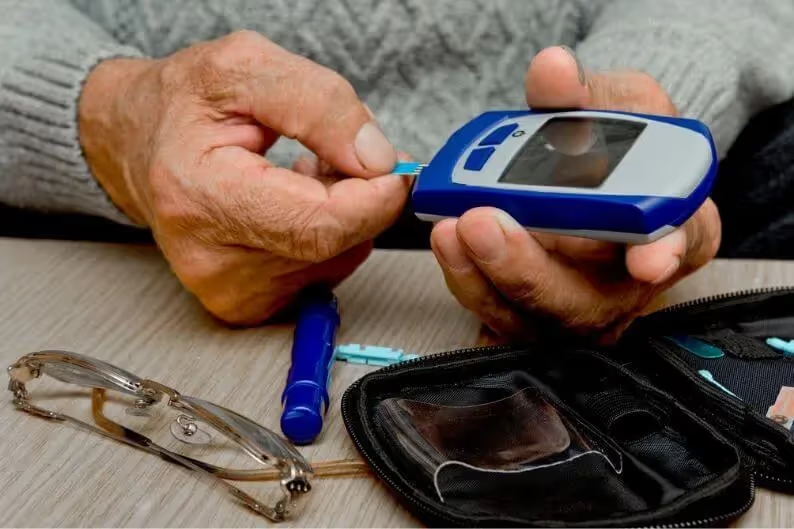Nearly 27% of people aged 65 and above are living with diabetes, according to the American Diabetes Association. It's a serious disease that occurs when your blood sugar gets too high. With the condition being so prevalent in the aging population, it's important to know the signs and symptoms of diabetes in older adults, along with some prevention methods.
Before we get into those things, you first need to understand a little bit more about why diabetes is.
Types of Diabetes
As briefly mentioned above, those with diabetes have high blood glucose levels. Your blood sugar is important because it's a major source of energy for cells that fuel your muscles and tissues as well as your brain.
Our bodies create blood glucose from the food we eat. In order to use that glucose, the body needs insulin, which helps glucose make it into our cells. When your body doesn't make enough insulin or doesn't use it in the right way, that can lead to excess glucose in your blood, which can cause health problems.
There are 2 chronic diabetes conditions as well as two types that are potentially reversible.
Type 1 Diabetes
Type 1 diabetes is when the body doesn't make insulin. This type is most common in children and younger adults.
There's no known cause for type 1 diabetes. What happens is your immune system destroys the insulin-producing cells in your pancreas, which leaves you with little to no insulin. Due to that, sugar will build up in the bloodstream.
Type 2 Diabetes
With type 2 diabetes the body doesn't make or use insulin very well. This is the most common type of diabetes in middle age and older adults.
While some genetic and environmental factors are thought to play a role in type 2 diabetes, being overweight also has a strong link to the condition. Not everyone with type 2 diabetes is overweight, though.
Prediabetes
If your blood sugar is elevated but not quite high enough to be considered diabetes, you have what's called prediabetes. If you have hit this stage you are at a higher risk of developing type 2 diabetes, heart attack, or having a stroke.
During this stage, there is still the chance of preventing or delaying the onset of type 2 diabetes. Things like losing weight, being physically active, eating right, and quitting smoking if you're a smoker can all make a big difference.
You should speak with your doctor about the right moves to make for your situation.
Risk Factors
Certain factors can leave you at greater risk of hypoglycemia.
Family history is a common risk factor in both type 1 and type 2. For type 1 diabetes, environmental factors, having damaging immune system cells (called autoantibodies), and geographic location are the main risk factors.
When it comes to type 2 diabetes, there are more factors to take into account, such as:
- Weight
- Inactivity
- Race or ethnicity
- Age
- Gestational diabetes
- Polycystic ovary syndrome
- High blood pressure
- Abnormal cholesterol and triglyceride levels
Signs Of Undiagnosed Diabetes
There are various symptoms to watch out for that could indicate you have diabetes. While the symptoms can be the same for type 1 and type 2 diabetes, symptoms often show up more rapidly and severely in people who have type 1.
The symptoms to look for include:
- Feeling tired
- Increased hunger
- Increased thirst
- Unexplained weight loss
- Frequent urination
- Blurred vision
- Frequent infections
- Slow-healing sores
Again, diabetes in older adults tends to be type 2, so you may only notice mild symptoms at first. There are times when there might not be any symptoms, as well. If you do experience any of those, you should discuss it with your doctor immediately. The sooner you are diagnosed with the condition the better.
Complications of Diabetes
People with diabetes are at risk of several complications developing over time, especially if the condition isn't managed properly. Those conditions can turn into disabling or life-threatening complications.
The most common complications include:
- Heart disease
- Nerve damage
- Kidney disease
- Eye damage
- Foot damage
- Skin conditions
- Hearing impairment
- Alzheimer's disease
- Depression
- Cognitive impairments
With such severe complications possibly arising from this condition, the best action is to practice prevention methods and keep your blood glucose at the right levels.
Diabetes Management
Diabetes in older adults will usually be type 2, so that's what we'll talk about managing here.
It's common for type 2 diabetes to be controlled using just diet and exercise. Some patients may need pills, insulin injections, or other medications to keep blood glucose or other health conditions related to diabetes under control.
In order to keep your diabetes in check, it's going to take some lifestyle changes.
After a diagnosis, your physician will help you with a diabetes management plan. It will include things like how to track your glucose levels, making healthy food choices, leading an active lifestyle, and keeping track of your medications.
Aside from what's mentioned above, you'll also need to manage other conditions like blood pressure and cholesterol, along with quitting smoking, having yearly eye exams, getting your kidneys checked, getting flu shots and the pneumonia vaccine, and caring for your teeth, gums, skin, and feet.




